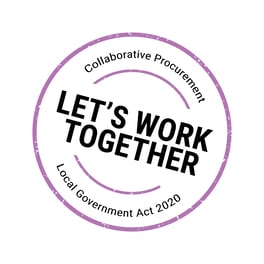Collaborative Procurement: The future of Strategic Procurement
Section 109 of The Local Government Act 2020 sets out the procurement requirements for local government entities, which includes a sub-item requiring Councils to seek collaboration with other Councils and public bodies in the procurement of goods or services and to demonstrate that requirement in their planning process.

This aligns with the state government’s efforts to create collaboration among Victorian Councils in order to encourage the sharing of common goods and services, strengthen relationships with suppliers and commissioners, help deliver cost savings, and streamline procurement across the state.
The term ‘collaborative procurement’ has been applied to this initiative and is a positive strategic move designed to consolidate resources and streamline procurement efforts both in Australia and around the world. But why should Councils and public bodies consider collaborative efforts in their procurement strategies, and how can we help?
Cost consolidation and collaborative purchasing
An attractive benefit of collaborative procurement, purchasing, and tender is the savings it can produce, easing the strain on public sector budgets and/or the need to make public money extend as far as possible.
It can also have a positive effect on pricing. By aligning themselves with a number of organisations to purchase the same product or service, Councils can capitalise on volume discounts to secure better pricing and save money.
Using our mobile bins contract as an example, if neighbouring Councils were all looking to purchase the new bins for their community as part of the new Victorian Four Bins Campaign, they could consolidate their budget and utilise the same trusted supplier. This would ensure the same quality across all communities and help Councils save money by securing volume discounts.
By bringing together budgets from multiple organisations to approach the market with an aggregate requirement, they have more buying and negotiating power and can secure a better deal.
Streamlining processes
Collaborative procurement, purchasing and tender provides us and our members the opportunity to standardise processes. This comes with its own benefits such as a reduced need for total stock holding or a reduced need for staff training. For example, if different Councils collaborate so that they all use the same supplier with the same specifications, sourcing itself becomes easier and any documentation can be shared across multiple organisations.
From an aggregator's perspective, dedicating our resources to a smaller number of bigger projects means we can use our extensive experience to its full potential. While we know there can’t always be a one-size-fits-all approach to every project, by combining procurement efforts for members seeking solutions to the same problems or to adhere to the same regulations, we can use our years of expertise and extensive supplier network to find the best supplier – at the best cost for everyone.
A byproduct of standardisation is the positive effect it has on time management. Currently, there is significant duplication of efforts when multiple government agencies are seeking procurement contracts for the same or similar products. By reducing the duplication of effort, you save more time (and money).
Better brainstorming through a collaborative procurement approach
The phrase ‘many hands make light work’ rings true here. There are some amazing, creative minds in every business and bringing those minds together to dream up solutions to shared problems has the potential to yield better-than-ever results.
Effective collaboration helps you learn more that can benefit you and your team and provide benefits to your community in terms of social value. By drawing on the expertise of those in the same or similar industries and gaining additional insights into best practices, we can ensure that we’re providing the best solutions when it comes to collaborative procurement.
Improved supplier relationships
Collaboration gives aggregators the chance to be trustworthy clients to their suppliers, thereby strengthening the client-supplier relationship. Strengthening these relationships, in turn, helps aggregators like us to demonstrate to our members that we have exactly what they need and can provide it at the best price.
By collaborating with suppliers, following their capabilities, and determining where their ideas are coming from, we can get a better understanding of what they can deliver and in what timeframes. A major part of collaborative procurement is being a reliable client for your suppliers as much as it is being a worthy aggregator for our members
Better supplier relationships also mean that supply chain management is often easier. The collaborative working arrangement benefits all parties.
Of course, concessions will need to be made for certain situations or projects that would need to operate outside of a collaborative procurement process, such as disasters or emergencies, novated contracts or proven monopolies on specific contracts, and those would be addressed as required.
Procurement Australia is here to support our members as they navigate this new policy framework and can help you develop or broaden your Procurement Plan, connect you with our extensive supplier list, and assess your current projects to identify avenues for collaborative procurement processes.
Reach out today to get started.


